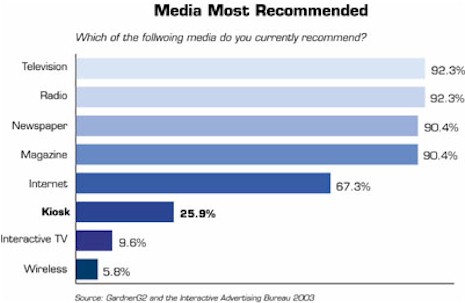News
Kiosks as a media choice
April 25, 2005
I don't want to toot my own horn, but I still seem to be the only guy out there who truly believes that kiosks are not only a great marketing and advertising tool, but will grow as a viable media delivery vehicle faster than any other medium. The popularity of plasma displays (a market they call the Dynamic Digital Signage industry) went from nowhere to just about everywhere overnight. This market too, I believe, is on the path to be absorbed by kiosk technology and advertisers are following suit.
Plasma screens and TV monitors are popping up in tons of retail and financial environments, and why not? If you want to bring that dance club feeling into your business, digital displays and signage work wonderfully. The old static printed point of purchase displays are so 90s, aren't they? The new displays though have visual appeal that customers have come to expect and, let's be honest, need to make their eyeballs move.
I'm going out on a limb and predicting that digital displays will create a revolution. In the future, plasmas and touchscreen kiosks will replace all the antiquated printed signs so familiar to the retail business. Why? We consumer have experienced advertising desensitization on a major scale. Our brains, through evolution, have learned to bypass and expel advertising messages at an alarming rate. The new display technology will be the holy grail of 21st century marketing.
The cool thing about plasmas is that they can present intense colors and graphics in a way that consumers find interesting, almost head-turning. For those who want to put plasmas out, it's nice to have the ability to refresh the content, messages, and branding in real-time. In addition, there's the flexibility of either running cool graphics or getting a little more sophisticated with video. Either way, the plasmas are a great step in enhancing the business environment.
Plasmas are limited though. You really have to hope that a consumer gets the message at a glance. Interactive kiosks on the other hand are built on an environment that requires customers to take the process one step further. If they're looking for information, the kiosk then draws upon computing power to present options, a selection of information, and even to conduct transactions. Expect to see in the near future more kiosks using plasmas as secondary displays and kiosk terminals with much larger monitors.
 |
Being known as a researcher in the area of kiosks and advertising, I usually get about ten to fifteen calls per week from companies putting kiosks out. The most often question I'm asked is, "Do advertisers even know what kiosks are and how do I sell my advertising space to them?" Four years ago I would have answered that question with a resounding "NO!" Today though, advertisers and media buyers are astute to interactive advertising and the term kiosk is something they are familiar with, and even interested in.
The learning curve of media buying agency's awareness of interactive kiosks was slow. Coming from other medium like print and television, it was difficult if not all together impossible to understand how they could take a clients budget and justify spending it on a medium that wasn't tested. In addition, media buyers had no way to see how many terminals were available or how in the world they would use their neat little flight casting programs to put scheduled advertising on the kiosks. Time and sophistication have put those issues behind us and advertisers are riper than ever to give kiosks a try.
Last year GartnerG2 addressed in a report the issues surrounding brand strength and interactive advertising. The research was paramount to understanding the habits of chief media buyers at ad agencies. The results pointed to a growing trend within the media-buying realm that interactive advertising is legit; especially when their clients are so desperately trying to find new methods of reaching consumers to drive sales and traffic.
A combination of client pressure, the ability to hit consumers where they are shopping, etc., delivering real-time messages, creating verifiable sales increases, and the novelty of trying a new medium have put interactive kiosks on the media-buying roadmap. 44 percent of those surveyed for the report said they plan to recommend kiosk advertising?the largest increase for any interactive media.*
* GarnterG2's report Brand Strength is Critical to Interactive Advertising Growth, 2003. Special permission granted to KIOSK magazine by GartnerG2.
Research
www.gartner.com
www.iab.com
Originally published in the Mar/Apr 2004 issue ofKiosk magazine.







